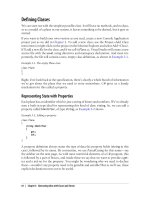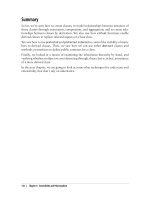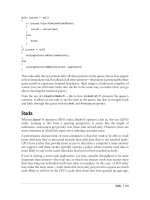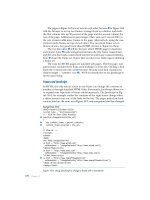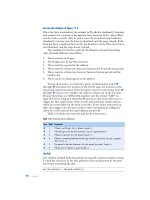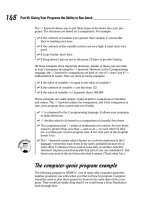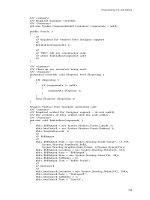Programming C# 2nd Edition phần 5 ppt
Bạn đang xem bản rút gọn của tài liệu. Xem và tải ngay bản đầy đủ của tài liệu tại đây (888.69 KB, 59 trang )
Programming C#, 2nd Edition
231
string string1 =
"04:03:27 Jesse 0.0.0.127 Liberty ";
// regular expression which groups company twice
Regex theReg = new Regex(@"(?<time>(\d|\:)+)\s" +
@"(?<company>\S+)\s" +
@"(?<ip>(\d|\.)+)\s" +
@"(?<company>\S+)\s");
// get the collection of matches
MatchCollection theMatches =
theReg.Matches(string1);
// iterate through the collection
foreach (Match theMatch in theMatches)
{
if (theMatch.Length != 0)
{
Console.WriteLine("theMatch: {0}",
theMatch.ToString( ));
Console.WriteLine("time: {0}",
theMatch.Groups["time"]);
Console.WriteLine("ip: {0}",
theMatch.Groups["ip"]);
Console.WriteLine("Company: {0}",
theMatch.Groups["company"]);
// iterate over the captures collection
// in the company group within the
// groups collection in the match
foreach (Capture cap in
theMatch.Groups["company"].Captures)
{
Console.WriteLine("cap: {0}",cap.ToString( ));
}
}
}
}
}
}
Output:
theMatch: 04:03:27 Jesse 0.0.0.127 Liberty
time: 04:03:27
ip: 0.0.0.127
Company: Liberty
cap: Jesse
cap: Liberty
The code in bold iterates through the Captures collection for the Company group.
foreach (Capture cap in
theMatch.Groups["company"].Captures)
Let's review how this line is parsed. The compiler begins by finding the collection that it will
iterate over.
theMatch is an object that has a collection named Groups. The Groups collection
has an indexer that takes a string and returns a single Group object. Thus, the following line
returns a single Group object:
Programming C#, 2nd Edition
232
theMatch.Groups["company"]
The Group object has a collection named Captures. Thus, the following line returns a
Captures collection for the Group stored at Groups["company"] within the theMatch object:
theMatch.Groups["company"].Captures
The foreach loop iterates over the Captures collection, extracting each element in turn and
assigning it to the local variable cap, which is of type Capture. You can see from the output
that there are two capture elements: Jesse and Liberty. The second one overwrites the first
in the group, and so the displayed value is just Liberty. However, by examining the
Captures collection, you can find both values that were captured.
Programming C#, 2nd Edition
233
Chapter 11. Handling Exceptions
C#, like many object-oriented languages, handles errors and abnormal conditions with
exceptions. An exception is an object that encapsulates information about an unusual program
occurrence.
It is important to distinguish between bugs, errors, and exceptions. A bug is a programmer
mistake that should be fixed before the code is shipped. Exceptions are not a protection
against bugs. Although a bug might cause an exception to be thrown, you should not rely on
exceptions to handle your bugs. Rather, you should fix the bug.
An error is caused by user action. For example, the user might enter a number where a letter
is expected. Once again, an error might cause an exception, but you can prevent that by
catching errors with validation code. Whenever possible, errors should be anticipated and
prevented.
Even if you remove all bugs and anticipate all user errors, you will still run into predictable
but unpreventable problems, such as running out of memory or attempting to open a file that
no longer exists. You cannot prevent exceptions, but you can handle them so that they do not
bring down your program.
When your program encounters an exceptional circumstance, such as running out of memory,
it throws (or "raises") an exception. When an exception is thrown, execution of the current
function halts and the stack is unwound until an appropriate exception handler is found.
This means that if the currently running function does not handle the exception, the current
function will terminate and the calling function will get a chance to handle the exception. If
none of the calling functions handles it, the exception will ultimately be handled by the CLR,
which will abruptly terminate your program.
An exception handler is a block of code designed to handle the exception you've thrown.
Exception handlers are implemented as catch statements. Ideally, if the exception is caught
and handled, the program can fix the problem and continue. Even if your program can't
continue, by catching the exception you have an opportunity to print a meaningful error
message and terminate gracefully.
If there is code in your function that must run regardless of whether an exception is
encountered (e.g., to release resources you've allocated), you can place that code in a finally
block, where it is certain to run, even in the presence of exceptions.
11.1 Throwing and Catching Exceptions
In C#, you can throw only objects of type System.Exception, or objects derived from that
type. The CLR
System namespace includes a number of exception types that can be used by
your program. These exception types include ArgumentNullException,
InvalidCastException, and OverflowException, as well as many others.
Programming C#, 2nd Edition
234
11.1.1 The throw Statement
To signal an abnormal condition in a C# class, you throw an exception. To do this, use the
keyword throw. This line of code creates a new instance of System.Exception and then
throws it:
throw new System.Exception( );
Throwing an exception immediately halts execution while the CLR searches for an exception
handler. If an exception handler cannot be found in the current method, the runtime unwinds
the stack, popping up through the calling methods until a handler is found. If the runtime
returns all the way through Main( ) without finding a handler, it terminates the program.
Example 11-1 illustrates.
Example 11-1. Throwing an exception
namespace Programming_CSharp
{
using System;
public class Test
{
public static void Main( )
{
Console.WriteLine("Enter Main ");
Test t = new Test( );
t.Func1( );
Console.WriteLine("Exit Main ");
}
public void Func1( )
{
Console.WriteLine("Enter Func1 ");
Func2( );
Console.WriteLine("Exit Func1 ");
}
public void Func2( )
{
Console.WriteLine("Enter Func2 ");
throw new System.Exception( );
Console.WriteLine("Exit Func2 ");
}
}
}
Output:
Enter Main
Enter Func1
Enter Func2
Exception occurred: System.Exception: An exception of type
System.Exception was thrown.
at Programming_CSharp.Test.Func2( )
in exceptions01.cs:line 26
at Programming_CSharp.Test.Func1( )
in exceptions01.cs:line 20
Programming C#, 2nd Edition
235
at Programming_CSharp.Test.Main( )
in exceptions01.cs:line 12
This simple example writes to the console as it enters and exits each method. Main( ) creates
an instance of type Test and call Func1( ). After printing out the Enter Func1 message,
Func1( ) immediately calls Func2( ). Func2( ) prints out the first message and throws an
object of type System.Exception.
Execution immediately stops, and the CLR looks to see if there is a handler in Func2( ).
There is not, and so the runtime unwinds the stack (never printing the exit statement) to
Func1( ). Again, there is no handler, and the runtime unwinds the stack back to Main( ).
With no exception handler there, the default handler is called, which prints the error message.
11.1.2 The catch Statement
In C#, an exception handler is called a catch block and is created with the catch keyword.
In Example 11-2, the
throw statement is executed within a try block, and a catch block is
used to announce that the error has been handled.
Example 11-2. Catching an exception
namespace Programming_CSharp
{
using System;
public class Test
{
public static void Main( )
{
Console.WriteLine("Enter Main ");
Test t = new Test( );
t.Func1( );
Console.WriteLine("Exit Main ");
}
public void Func1( )
{
Console.WriteLine("Enter Func1 ");
Func2( );
Console.WriteLine("Exit Func1 ");
}
public void Func2( )
{
Console.WriteLine("Enter Func2 ");
try
{
Console.WriteLine("Entering try block ");
throw new System.Exception( );
Console.WriteLine("Exiting try block ");
}
Programming C#, 2nd Edition
236
catch
{
Console.WriteLine(
"Exception caught and handled.");
}
Console.WriteLine("Exit Func2 ");
}
}
}
Output:
Enter Main
Enter Func1
Enter Func2
Entering try block
Exception caught and handled.
Exit Func2
Exit Func1
Exit Main
Example 11-2 is identical to Example 11-1 except that now the program includes a try/catch
block. You would typically put the try block around a potentially "dangerous" statement,
such as accessing a file, allocating memory, and so forth.
Following the try statement is a generic catch statement. The catch statement in
Example 11-2 is generic because you haven't specified what kind of exceptions to catch. In
this case, the statement will catch any exceptions that are thrown. Using catch statements to
catch specific types of exceptions is discussed later in this chapter.
11.1.2.1 Taking corrective action
In Example 11-2, the catch statement simply reports that the exception has been caught and
handled. In a real-world example, you might take corrective action to fix the problem that
caused an exception to be thrown. For example, if the user is trying to open a read-only file,
you might invoke a method that allows the user to change the attributes of the file. If the
program has run out of memory, you might give the user an opportunity to close other
applications. If all else fails, the catch block can print an error message so that the user
knows what went wrong.
11.1.2.2 Unwinding the call stack
Examine the output of Example 11-2 carefully. You see the code enter Main( ), Func1( ),
Func2( ), and the try block. You never see it exit the try block, though it does exit
Func2( ), Func1( ), and Main( ). What happened?
When the exception is thrown, execution halts immediately and is handed to the catch block.
It never returns to the original code path. It never gets to the line that prints the exit
statement for the
try block. The catch block handles the error, and then execution falls
through to the code following
catch.
Without catch the call stack unwinds, but with catch it does not unwind as a result of the
exception. The exception is now handled; there are no more problems and the program
Programming C#, 2nd Edition
237
continues. This becomes a bit clearer if you move the try/catch blocks up to Func1( ), as
shown in Example 11-3.
Example 11-3. Catch in a calling function
namespace Programming_CSharp
{
using System;
public class Test
{
public static void Main( )
{
Console.WriteLine("Enter Main ");
Test t = new Test( );
t.Func1( );
Console.WriteLine("Exit Main ");
}
public void Func1( )
{
Console.WriteLine("Enter Func1 ");
try
{
Console.WriteLine("Entering try block ");
Func2( );
Console.WriteLine("Exiting try block ");
}
catch
{
Console.WriteLine(
"Exception caught and handled.");
}
Console.WriteLine("Exit Func1 ");
}
public void Func2( )
{
Console.WriteLine("Enter Func2 ");
throw new System.Exception( );
Console.WriteLine("Exit Func2 ");
}
}
}
Output:
Enter Main
Enter Func1
Entering try block
Enter Func2
Exception caught and handled.
Exit Func1
Exit Main
This time the exception is not handled in Func2( ); it is handled in Func1( ). When
Func2( ) is called, it prints the Enter statement and then throws an exception. Execution
Programming C#, 2nd Edition
238
halts and the runtime looks for a handler, but there isn't one. The stack unwinds, and the
runtime finds a handler in Func1( ). The catch statement is called, and execution resumes
immediately following the catch statement, printing the Exit statement for Func1( ) and
then for Main( ).
Make sure you are comfortable with why the Exiting Try Block statement and the Exit
Func2
statement are not printed. This is a classic case where putting the code into a debugger
and then stepping through it can make things very
clear.
11.1.2.3 Creating dedicated catch statements
So far, you've been working only with generic catch statements. You can create dedicated
catch statements that handle only some exceptions and not others, based on the type of
exception thrown. Example 11-4 illustrates how to specify which exception you'd like to
handle.
Example 11-4. Specifying the exception to catch
namespace Programming_CSharp
{
using System;
public class Test
{
public static void Main( )
{
Test t = new Test( );
t.TestFunc( );
}
// try to divide two numbers
// handle possible exceptions
public void TestFunc( )
{
try
{
double a = 5;
double b = 0;
Console.WriteLine ("{0} / {1} = {2}",
a, b, DoDivide(a,b));
}
// most derived exception type first
catch (System.DivideByZeroException)
{
Console.WriteLine(
"DivideByZeroException caught!");
}
catch (System.ArithmeticException)
{
Console.WriteLine(
"ArithmeticException caught!");
}
Programming C#, 2nd Edition
239
// generic exception type last
catch
{
Console.WriteLine(
"Unknown exception caught");
}
}
// do the division if legal
public double DoDivide(double a, double b)
{
if (b == 0)
throw new System.DivideByZeroException( );
if (a == 0)
throw new System.ArithmeticException( );
return a/b;
}
}
}
Output:
DivideByZeroException caught!
In this example, the DoDivide( ) method will not let you divide zero by another number, nor
will it let you divide a number by zero. It throws an instance of DivideByZeroException if
you try to divide by zero. If you try to divide zero by another number, there is no appropriate
exception dividing zero by another number is a legal mathematical operation and shouldn't
throw an exception at all. For the sake of this example, assume you don't want to allow
division by zero; you will throw an ArithmeticException.
When the exception is thrown, the runtime examines each exception handler in order and
matches the first one it can. When you run this with a=5 and b=7, the output is:
5 / 7 = 0.7142857142857143
As you'd expect, no exception is thrown. However, when you change the value of a to 0, the
output is:
ArithmeticException caught!
The exception is thrown, and the runtime examines the first exception,
DivideByZeroException. Because this does not match, it goes on to the next handler,
ArithmeticException, which does match.
In a final pass through, suppose you change
a to 7 and b to 0. This throws the
DivideByZeroException.
Programming C#, 2nd Edition
240
You have to be particularly careful with the order of the catch
statements, because the DivideByZeroException is derived from
ArithmeticException. If you reverse the catch statements,
the DivideByZeroException will match the ArithmeticException
handler and the exception will never get to
the DivideByZeroException handler. In fact, if their order is reversed,
it will be impossible for any exception to reach
the DivideByZeroException handler. The compiler will recognize that
the DivideByZeroException handler cannot be reached and will report
a compile error!
It is possible to distribute your try/catch statements, catching some specific exceptions in
one function and more generic exceptions in higher, calling functions. Your design goals
should dictate the exact design.
Assume you have a method A that calls another method B, which in turn calls method C.
Method C calls method D, which then calls method E. Method E is deep in your code;
methods B and A are higher up. If you anticipate that method E might throw an exception,
you should create a try/catch block deep in your code to catch that exception as close as
possible to the place where the problem arises. You might also want to create more general
exception handlers higher up in the code in case unanticipated exceptions slip by.
11.1.3 The finally Statement
In some instances, throwing an exception and unwinding the stack can create a problem. For
example, if you have opened a file or otherwise committed a resource, you might need an
opportunity to close the file or flush the buffer.
In C#, this is less of a problem than in other languages, such as C++,
because the garbage collection prevents the exception from causing a
memory leak.
In the event, however, that there is some action you must take regardless of whether an
exception is thrown, such as closing a file, you have two strategies to choose from. One
approach is to enclose the dangerous action in a try block and then to close the file in both
the
catch and try blocks. However, this is an ugly duplication of code, and it's error prone.
C# provides a better alternative in the finally block.
The code in the finally block is guaranteed to be executed regardless of whether an
exception is thrown. The TestFunc( ) method in Example 11-5 simulates opening a file as
its first action. The method undertakes some mathematical operations, and the file is closed. It
is possible that some time between opening and closing the file an exception will be thrown.
If this were to occur, it would be possible for the file to remain open. The developer knows
that no matter what happens, at the end of this method the file should be closed, so the file
close function call is moved to a finally block, where it will be executed regardless of
whether an exception is thrown.
Programming C#, 2nd Edition
241
Example 11-5. Using a finally block
namespace Programming_CSharp
{
using System;
public class Test
{
public static void Main( )
{
Test t = new Test( );
t.TestFunc( );
}
// try to divide two numbers
// handle possible exceptions
public void TestFunc( )
{
try
{
Console.WriteLine("Open file here");
double a = 5;
double b = 0;
Console.WriteLine ("{0} / {1} = {2}",
a, b, DoDivide(a,b));
Console.WriteLine (
"This line may or may not print");
}
// most derived exception type first
catch (System.DivideByZeroException)
{
Console.WriteLine(
"DivideByZeroException caught!");
}
catch
{
Console.WriteLine("Unknown exception caught");
}
finally
{
Console.WriteLine ("Close file here.");
}
}
// do the division if legal
public double DoDivide(double a, double b)
{
if (b == 0)
throw new System.DivideByZeroException( );
if (a == 0)
throw new System.ArithmeticException( );
return a/b;
}
}
}
Programming C#, 2nd Edition
242
Output:
Open file here
DivideByZeroException caught!
Close file here.
Output when b = 12:
Open file here
5 / 12 = 0.416666666666667
This line may or may not print
Close file here.
In this example, one of the catch blocks has been eliminated to save space and a finally
block has been added. Whether or not an exception is thrown, the finally block is executed,
and so in both output examples you see the message:
Close file here.
A finally block can be created with or without catch blocks, but a
finally block requires a try block to execute. It is an error to exit a
finally block with break, continue, return, or goto.
11.2 Exception Objects
So far you've been using the exception as a sentinel that is, the presence of the exception
signals the errors but you haven't touched or examined the Exception object itself. The
System.Exception object provides a number of useful methods and properties. The Message
property provides information about the exception, such as why it was thrown. The Message
property is read-only; the code throwing the exception can set the Message property as an
argument to the exception constructor.
The HelpLink property provides a link to the help file associated with the exception. This
property is read/write.
The StackTrace property is read-only and is set by the runtime. In Example 11-6, the
Exception.HelpLink property is set and retrieved to provide information to the user about
the DivideByZeroException. The StackTrace property of the exception is used to provide a
stack trace for the error statement. A stack trace displays the call stack : the series of method
calls that lead to the method in which the exception was thrown.
Example 11-6. Working with an exception object
namespace Programming_CSharp
{
using System;
public class Test
{
public static void Main( )
{
Test t = new Test( );
t.TestFunc( );
}
Programming C#, 2nd Edition
243
// try to divide two numbers
// handle possible exceptions
public void TestFunc( )
{
try
{
Console.WriteLine("Open file here");
double a = 12;
double b = 0;
Console.WriteLine ("{0} / {1} = {2}",
a, b, DoDivide(a,b));
Console.WriteLine (
"This line may or may not print");
}
// most derived exception type first
catch (System.DivideByZeroException e)
{
Console.WriteLine(
"\nDivideByZeroException! Msg: {0}",
e.Message);
Console.WriteLine(
"\nHelpLink: {0}", e.HelpLink);
Console.WriteLine(
"\nHere's a stack trace: {0}\n",
e.StackTrace);
}
catch
{
Console.WriteLine(
"Unknown exception caught");
}
finally
{
Console.WriteLine (
"Close file here.");
}
}
// do the division if legal
public double DoDivide(double a, double b)
{
if (b == 0)
{
DivideByZeroException e =
new DivideByZeroException( );
e.HelpLink =
"";
throw e;
}
if (a == 0)
throw new ArithmeticException( );
return a/b;
}
}
}
Programming C#, 2nd Edition
244
Output:
Open file here
DivideByZeroException! Msg: Attempted to divide by zero.
HelpLink:
Here's a stack trace:
at Programming_CSharp.Test.DoDivide(Double a, Double b)
in c:\ exception06.cs:line 56
at Programming_CSharp.Test.TestFunc( )
in exception06.cs:line 22
Close file here.
In the output, the stack trace lists the methods in the reverse order in which they were called;
that is, it shows that the error occurred in DoDivide( ), which was called by TestFunc( ).
When methods are deeply nested, the stack trace can help you understand the order of method
calls.
In this example, rather than simply throwing a DivideByZeroException, you create a new
instance of the exception:
DivideByZeroException e = new DivideByZeroException( );
You do not pass in a custom message, and so the default message will be printed:
DivideByZeroException! Msg: Attempted to divide by zero.
You can modify this line of code to pass in a default message:
new DivideByZeroException(
"You tried to divide by zero which is not meaningful");
In this case, the output message will reflect the custom message:
DivideByZeroException! Msg:
You tried to divide by zero which is not
meaningful
Before throwing the exception, set the HelpLink property:
e.HelpLink = "";
When this exception is caught, the program prints the message and the HelpLink:
catch (System.DivideByZeroException e)
{
Console.WriteLine("\nDivideByZeroException! Msg: {0}",
e.Message);
Console.WriteLine("\nHelpLink: {0}", e.HelpLink);
This allows you to provide useful information to the user. In addition, it prints the
StackTrace by getting the StackTrace property of the exception object:
Programming C#, 2nd Edition
245
Console.WriteLine("\nHere's a stack trace: {0}\n",
e.StackTrace);
The output of this call reflects a full StackTrace leading to the moment the exception was
thrown:
Here's a stack trace:
at Programming_CSharp.Test.DoDivide(Double a, Double b)
in c:\ exception06.cs:line 56
at Programming_CSharp.Test.TestFunc( )
in exception06.cs:line 22
Note that I've shortened the pathnames, so your printout might look a little different.
11.3 Custom Exceptions
The intrinsic exception types the CLR provides, coupled with the custom messages shown in
the previous example, will often be all you need to provide extensive information to a catch
block when an exception is thrown. There will be times, however, when you want to provide
more extensive information or need special capabilities in your exception. It is a trivial matter
to create your own custom exception class; the only restriction is that it must derive (directly
or indirectly) from System.ApplicationException. Example 11-7 illustrates the creation of
a custom exception.
Example 11-7. Creating a custom exception
namespace Programming_CSharp
{
using System;
public class MyCustomException :
System.ApplicationException
{
public MyCustomException(string message):
base(message)
{
}
}
public class Test
{
public static void Main( )
{
Test t = new Test( );
t.TestFunc( );
}
// try to divide two numbers
// handle possible exceptions
public void TestFunc( )
{
try
{
Console.WriteLine("Open file here");
double a = 0;
double b = 5;
Programming C#, 2nd Edition
246
Console.WriteLine ("{0} / {1} = {2}",
a, b, DoDivide(a,b));
Console.WriteLine (
"This line may or may not print");
}
// most derived exception type first
catch (System.DivideByZeroException e)
{
Console.WriteLine(
"\nDivideByZeroException! Msg: {0}",
e.Message);
Console.WriteLine(
"\nHelpLink: {0}\n", e.HelpLink);
}
catch (MyCustomException e)
{
Console.WriteLine(
"\nMyCustomException! Msg: {0}",
e.Message);
Console.WriteLine(
"\nHelpLink: {0}\n", e.HelpLink);
}
catch
{
Console.WriteLine(
"Unknown exception caught");
}
finally
{
Console.WriteLine ("Close file here.");
}
}
// do the division if legal
public double DoDivide(double a, double b)
{
if (b == 0)
{
DivideByZeroException e =
new DivideByZeroException( );
e.HelpLink=
"";
throw e;
}
if (a == 0)
{
MyCustomException e =
new MyCustomException(
"Can't have zero divisor");
e.HelpLink =
"
throw e;
}
return a/b;
}
}
}
Programming C#, 2nd Edition
247
MyCustomException
is derived from System.ApplicationException and consists of
nothing more than a constructor that takes a string message that it passes to its base class, as
described in Chapter 4. In this case, the advantage of creating this custom exception class is
that it better reflects the particular design of the Test class, in which it is not legal to have a
zero divisor. Using the ArithmeticException rather than a custom exception would work as
well, but it might confuse other programmers because a zero divisor wouldn't normally be
considered an arithmetic error.
11.4 Rethrowing Exceptions
You might want your catch block to take some initial corrective action and then rethrow the
exception to an outer try block (in a calling function). It might rethrow the same exception,
or it might throw a different one. If it throws a different one, it may want to embed the
original exception inside the new one so that the calling method can understand the exception
history. The InnerException property of the new exception retrieves the original exception.
Because the InnerException is also an exception, it too might have an inner exception.
Thus, an entire chain of exceptions can be nested one within the other, much like Ukrainian
dolls are contained one within the other. Example 11-8 illustrates.
Example 11-8. Rethrowing and inner exceptions
namespace Programming_CSharp
{
using System;
public class MyCustomException : System.ApplicationException
{
public MyCustomException(
string message,Exception inner):
base(message,inner)
{
}
}
public class Test
{
public static void Main( )
{
Test t = new Test( );
t.TestFunc( );
}
public void TestFunc( )
{
try
{
DangerousFunc1( );
}
Programming C#, 2nd Edition
248
// if you catch a custom exception
// print the exception history
catch (MyCustomException e)
{
Console.WriteLine("\n{0}", e.Message);
Console.WriteLine(
"Retrieving exception history ");
Exception inner =
e.InnerException;
while (inner != null)
{
Console.WriteLine(
"{0}",inner.Message);
inner =
inner.InnerException;
}
}
}
public void DangerousFunc1( )
{
try
{
DangerousFunc2( );
}
// if you catch any exception here
// throw a custom exception
catch(System.Exception e)
{
MyCustomException ex =
new MyCustomException(
"E3 - Custom Exception Situation!",e);
throw ex;
}
}
public void DangerousFunc2( )
{
try
{
DangerousFunc3( );
}
// if you catch a DivideByZeroException take some
// corrective action and then throw a general exception
catch (System.DivideByZeroException e)
{
Exception ex =
new Exception(
"E2 - Func2 caught divide by zero",e);
throw ex;
}
}
public void DangerousFunc3( )
{
try
{
DangerousFunc4( );
}
Programming C#, 2nd Edition
249
catch (System.ArithmeticException)
{
throw;
}
catch (System.Exception)
{
Console.WriteLine(
"Exception handled here.");
}
}
public void DangerousFunc4( )
{
throw new DivideByZeroException("E1 - DivideByZero Exception");
}
}
}
Output:
E3 - Custom Exception Situation!
Retrieving exception history
E2 - Func2 caught divide by zero
E1 - DivideByZeroException
Because this code has been stripped to the essentials, the output might leave you scratching
your head. The best way to see how this code works is to use the debugger to step through it.
Begin by calling DangerousFunc1( ) in a try block:
try
{
DangerousFunc1( );
}
DangerousFunc1( )
calls DangerousFunc2( ), which calls DangerousFunc3( ), which in
turn calls DangerousFunc4( ). All these calls are in their own try blocks. At the end,
DangerousFunc4( ) throws a DivideByZeroException. System.DivideByZeroException
normally has its own error message, but you are free to pass in a custom message. Here, to
make it easier to identify the sequence of events, the custom message E1 -
DivideByZeroException is passed in.
The exception thrown in DangerousFunc4( ) is caught in the catch block in
DangerousFunc3( ). The logic in DangerousFunc3( ) is that if any ArithmeticException
is caught (such as DivideByZeroException), it takes no action; it just rethrows the
exception:
catch (System.ArithmeticException)
{
throw;
}
The syntax to rethrow the exact same exception (without modifying it) is just the word throw.
Programming C#, 2nd Edition
250
The exception is thus rethrown to DangerousFunc2( ), which catches it, takes some
corrective action, and throws a new exception of type Exception. In the constructor to that
new exception, DangerousFunc2( ) passes in a custom message (E2 - Func2 caught
divide by zero
) and the original exception. Thus, the original exception (E1) becomes the
InnerException for the new exception (E2). DangerousFunc2( ) then throws this new E2
exception to DangerousFunc1( ).
DangerousFunc1( ) catches the exception, does some work, and creates a new exception of
type MyCustomException. It passes a new string (E3 - Custom Exception Situation!) to
the constructor as well as the exception it just caught (E2). Remember, the exception it just
caught is the exception with a DivideByZeroException (E1) as its inner exception. At this
point, you have an exception of type MyCustomException (E3), with an inner exception of
type Exception (E2), which in turn has an inner exception of type
DivideByZeroException (E1). All this is then thrown to the test function, where it is
caught.
When the
catch function runs, it prints the message:
E3 - Custom Exception Situation!
and then drills down through the layers of inner exceptions, printing their messages:
while (inner != null)
{
Console.WriteLine("{0}",inner.Message);
inner = inner.InnerException;
}
The output reflects the chain of exceptions thrown and caught:
Retrieving exception history
E2 - Func2 caught divide by zero
E1 - DivideByZero Exception
Programming C#, 2nd Edition
251
Chapter 12. Delegates and Events
When a head of state dies, the president of the United States typically does not have time to
attend the funeral personally. Instead, he dispatches a delegate. Often this delegate is the vice
president, but sometimes the VP is unavailable and the president must send someone else,
such as the secretary of state or even the first lady. He doesn't want to "hardwire" his
delegated authority to a single person; he might delegate this responsibility to anyone who is
able to execute the correct international protocol.
The president defines in advance what authority will be delegated (attend the funeral), what
parameters will be passed (condolences, kind words), and what value he hopes to get back
(good will). He then assigns a particular person to that delegated responsibility at "runtime" as
the course of his presidency progresses.
In programming, you are often faced with situations where you need to execute a particular
action, but you don't know in advance which method, or even which object, you'll want to call
upon to execute that action. For example, a button might know that it must notify some object
when it is pushed, but it might not know which object or objects need to be notified. Rather
than wiring the button to a particular object, you will connect the button to a delegate and
then resolve that delegate to a particular method when the program executes.
In the early, dark, and primitive days of computing, a program would begin execution and
then proceed through its steps until it completed. If the user was involved, the interaction was
strictly controlled and limited to filling in fields.
Today's Graphical User Interface (GUI) programming model requires a different approach,
known as event-driven programming. A modern program presents the user interface and waits
for the user to take an action. The user might take many different actions, such as choosing
among menu selections, pushing buttons, updating text fields, clicking icons, and so forth.
Each action causes an event to be raised. Other events can be raised without direct user action,
such as events that correspond to timer ticks of the internal clock, email being received, file-
copy operations completing, etc.
An event is the encapsulation of the idea that "something happened" to which the program
must respond. Events and delegates are tightly coupled concepts because flexible event
handling requires that the response to the event be dispatched to the appropriate event handler.
An event handler is typically implemented in C# as a delegate.
Delegates are also used as callbacks so that one class can say to another "do this work and
when you're done, let me know." This second usage will be covered in detail in Chapter 21.
Delegates can also be used to specify methods that will only become known at runtime. This
topic is developed in the following sections.
12.1 Delegates
In C#, delegates are first-class objects, fully supported by the language. Technically, a
delegate is a reference type used to encapsulate a method with a specific signature and return
type. You can encapsulate any matching method in that delegate. (In C++ and many other
Programming C#, 2nd Edition
252
languages, you can accomplish this requirement with function pointers and pointers to
member functions. Unlike function pointers, delegates are object-oriented and type-safe.)
A delegate is created with the delegate keyword, followed by a return type and the signature
of the methods that can be delegated to it, as in the following:
public delegate int WhichIsFirst(object obj1, object obj2);
This declaration defines a delegate named WhichIsFirst, which will encapsulate any method
that takes two objects as parameters and returns an int.
Once the delegate is defined, you can encapsulate a member method with that delegate by
instantiating the delegate, i.e., passing in a method that matches the return type and signature.
12.1.1 Using Delegates to Specify Methods at Runtime
Delegates specify the kinds of methods that can handle events and implement callbacks in
your applications. They can also specify static and instance methods that won't be known until
runtime.
Suppose, for example, that you want to create a simple container class called a Pair that can
hold and sort any two objects passed to it. You can't know in advance what kind of objects a
Pair will hold, but by creating methods within those objects to which the sorting task can be
delegated, you can delegate responsibility for determining their order to the objects
themselves.
Different objects will sort differently; for example, a Pair of counter objects might sort in
numeric order, while a Pair of Buttons might sort alphabetically by their name. As the
author of the Pair class, you want the objects in the pair to have the responsibility of knowing
which should be first and which should be second. To accomplish this, insist that the objects
to be stored in the Pair provide a method that tells you how to sort the objects.
Define the method you require by creating a delegate that defines the signature and return
type of the method the object (e.g., Button) must provide to allow the Pair to determine
which object should be first and which should be second.
The Pair class defines a delegate, WhichIsFirst. The Sort method will take a parameter, an
instance of WhichIsFirst. When the Pair needs to know how to order its objects it will
invoke the delegate passing in its two objects as parameters. The responsibility for deciding
which of the two objects comes first is delegated to the method encapsulated by the delegate.
To test the delegate, create two classes: a Dog class and a Student class. Dogs and Students
have little in common, except they both implement methods that can be encapsulated by
WhichComesFirst; thus both Dog objects and Student objects are eligible to be held within
Pair objects.
In the test program, create a couple of
Students and a couple of Dogs, and store them each in
a Pair. You will then create delegate objects to encapsulate their respective methods that
match the delegate signature and return type, and ask the Pair objects to sort the Dog and
Student objects. Let's take this step by step.
Programming C#, 2nd Edition
253
Begin by creating a Pair constructor that takes two objects and stashes them away in a
private array:
public class Pair
{
// two objects, added in order received
public Pair(object firstObject, object secondObject)
{
thePair[0] = firstObject;
thePair[1] = secondObject;
}
// hold both objects
private object[]thePair = new object[2];
Next, you override ToString( ) to obtain the string value of the two objects:
public override string ToString( )
{
return thePair [0].ToString( ) + ", " + thePair[1].ToString( );
}
You now have two objects in your Pair and you can print out their values. You're ready to
sort them and print the results of the sort. You can't know in advance what kind of objects you
will have, so you would like to delegate the responsibility of deciding which object comes
first in the sorted Pair to the objects themselves. Thus, you require that each object stored in
a Pair implement a method to return which of the two comes first. The method will take two
objects (of whatever type) and return an enumerated value: theFirstComesFirst if the first
object comes first, and theSecondComesFirst if the second does.
These required methods will be encapsulated by the delegate WhichIsFirst that you define
within the Pair class:
public delegate comparison
WhichIsFirst(object obj1, object obj2);
The return value is of type comparison, the enumeration.
public enum comparison
{
theFirstComesFirst = 1,
theSecondComesFirst = 2
}
Any static method that takes two objects and returns a comparison can be encapsulated by
this delegate at runtime.
You can now define the
Sort method for the Pair class:
Programming C#, 2nd Edition
254
public void Sort(WhichIsFirst theDelegatedFunc)
{
if (theDelegatedFunc(thePair[0],thePair[1]) ==
comparison.theSecondComesFirst)
{
object temp = thePair[0];
thePair[0] = thePair[1];
thePair[1] = temp;
}
}
This method takes a parameter: a delegate of type WhichIsFirst named theDelegatedFunc.
The Sort( ) method delegates responsibility for deciding which of the two objects in the
Pair comes first to the method encapsulated by that delegate. It invokes the delegated method
in the body of the Sort( ) method and examines the return value, which will be one of the
two enumerated values of comparsion.
If the value returned is theSecondComesFirst, the objects within the pair are swapped;
otherwise no action is taken.
Notice that theDelegatedFunc is the name of the parameter to represent the method
encapsulated by the delegate. You can assign any method (with the appropriate return value
and signature) to this parameter. It is as if you had a method that took an int as a parameter:
int SomeMethod (int myParam){// }
The parameter name is myParam, but you can pass in any int value or variable. Similarly the
parameter name in the delegate example is theDelegatedFunc, but you can pass in any
method that meets the return value and signature defined by the delegate WhichIsFirst.
Imagine you are sorting students by name. Write a method that returns theFirstComesFirst
if the first student's name comes first, and returns theSecondComesFirst if the second
student's name does. If you pass in "Amy, Beth," the method returns theFirstComesFirst,
and if you pass in "Beth, Amy," it returns
theSecondComesFirst. If you get back
theSecondComesFirst, the Sort method reverses the items in its array, setting Amy to the
first position and Beth to the second.
Now add one more method,
ReverseSort, which will put the items into the array in reverse
order:
public void ReverseSort(WhichIsFirst theDelegatedFunc)
{
if (theDelegatedFunc(thePair[0], thePair[1]) ==
comparison.theFirstComesFirst)
{
object temp = thePair[0];
thePair[0] = thePair[1];
thePair[1] = temp;
}
}
The logic here is identical to the Sort( ), except that this method performs the swap if the
delegated method says that the first item comes first. Because the delegated function thinks
Programming C#, 2nd Edition
255
the first item comes first, and this is a reverse sort, the result you want is for the second item
to come first. This time if you pass in "Amy, Beth," the delegated function returns
theFirstComesFirst (i.e., Amy should come first). However, because this is a reverse sort it
swaps the values, setting Beth first. This allows you to use the same delegated function as you
used with Sort, without forcing the object to support a function that returns the reverse sorted
value.
Now all you need are some objects to sort. You'll create two absurdly simple classes: Student
and Dog. Assign Student objects a name at creation:
public class Student
{
public Student(string name)
{
this.name = name;
}
The Student class requires two methods, one to override ToString( ) and the other to be
encapsulated as the delegated method.
Student must override ToString( ) so that the ToString( ) method in Pair, which
invokes ToString( ) on the contained objects, will work properly; the implementation does
nothing more than return the student's name (which is already a string object):
public override string ToString( )
{
return name;
}
It must also implement a method to which Pair.Sort( ) can delegate the responsibility of
determining which of two objects comes first:
return (String.Compare(s1.name, s2.name) < 0 ?
comparison.theFirstComesFirst :
comparison.theSecondComesFirst);
String.Compare
( ) is a .NET Framework method on the String class that compares two
strings and returns less than zero if the first is smaller, greater than zero if the second is
smaller, and zero if they are the same. This method is discussed in some detail in Chapter 10.
Notice that the logic here returns
theFirstComesFirst only if the first string is smaller; if
they are the same or the second is larger, this method returns theSecondComesFirst.
Notice that the WhichStudentComesFirst( ) method takes two objects as parameters and
returns a comparison. This qualifies it to be a Pair.WhichIsFirst delegated method, whose
signature and return value it matches.
The second class is Dog. For our purposes, Dog objects will be sorted by weight, lighter dogs
before heavier. Here's the complete declaration of Dog:

